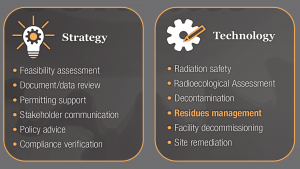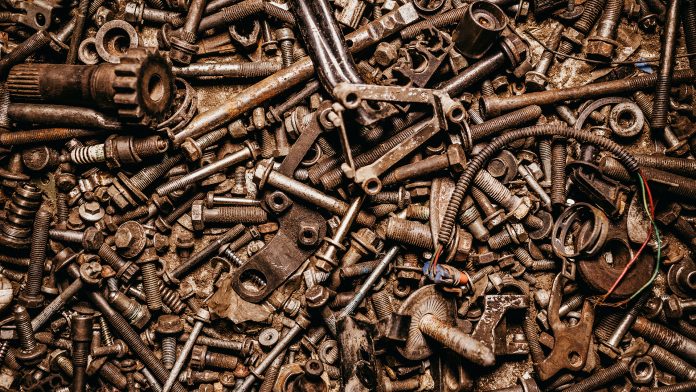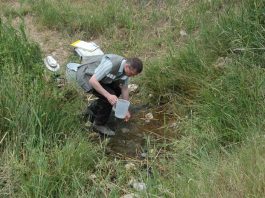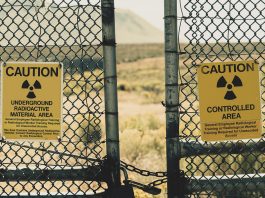GeoEnergy Consult analyses the steps needed to process and dispose of NORM residues compliantly and safely.
Mining and processing of Rare-Earths or further affected commodities can lead to an accumulation of NORM residues. Managing those requires a well-considered sequence of safe processing.
The best option for managing radioactive residues or waste is to minimise their generation, which initially requires critical analysis of relevant processes and could also involve recycling or reuse.
If all possibilities for minimisation are exhausted, due to their potential hazardousness, Naturally Occurring Radioactive Material (NORM) residues must be (radiologically) characterised, optionally decontaminated and treated/conditioned, and finally disposed of in licensed facilities.
Through all those steps, GeoEnergy Consult can support affected projects to handle NORM residues compliantly and safely, process residues (if indicated), and prevent adverse scenarios, like purposeless on-site accumulation.
Moreover, a good management of NORM residues helps organisations to operate efficiently and avoid liability risks.
Decontamination of equipment and facilities
Equipment and facilities of NORM-affected mining/processing (e.g. pipework for in situ leaching, other processing installations, etc.) can be contaminated by accumulating radioactive residues. In addition to lowering the overall efficiency, this can pose serious safety challenges.
Removal of radionuclides through decontamination leads to dose reduction, e.g. for the staff and prevents contamination from spreading. In a technical view, the huge advantages of removing radioactive contamination are:
- Waste volume reduction: by decontamination only a residual fraction (then containing the separated radionuclides) require further treatment as NORM waste, while the largest part becomes eligible for cheaper disposal as conventional waste; and
- Reusability of spent equipment (which otherwise would have to be disposed off), thus minimising the equipment consumption.
Various decontamination technologies for different applications are available. In the case of NORM, examples for suitable technologies are:
- Manual preparation (reusable);
- Water-jetting (reusable);
- (Electro-) Chemical bath (reusability needs verification); and
- Abrasive blasting (not reusable).
Manual preparation and water-jetting are relatively mild and usually allow reuse of decontaminated equipment. By contrast, as chemical decontamination can employ reagents like phosphoric acid, the opportunity for equipment reuse here needs to be verified specifically. Abrasive blasting with sand does usually not allow reuse due to the caused loss in material thickness. In general, all decontamination technologies can be conducted manually or are automated for higher throughput.

Treatment/conditioning (optionally)
Important objectives of treatment, if indicated, are further volume reduction and foremost fixation/immobilisation of radionuclides to prevent from spreading. For various residue types, different treatment or sequence of treatment options apply, including:
- Radionuclide extraction;
- Purification (of waste water);
- Incineration; and
- High-force compaction.
Disposing NORM residues/waste
If treatment is accomplished, NORM residues are ready for final disposal. Often the state is assumed to be responsible for actual disposal, meaning that operations only deliver (treated) residues to licensed disposal facilities. However, in the case of high volumes, for example, it can be justified that operations have an onsite disposal facility. Either way, several disposal options are available, including:
- Backfill in mined-out underground voids or open pits;
- Reinjection into original deposit (of flowable residues);
- Surface/near-surface disposal (e.g. landfill); or
- Underground disposal (e.g. co-disposal with radioactive waste).
The option realised depends both on technical/radiological properties and on country-specific regulatory requirements.
If residues comprise longlived radionuclides of increased amount/concentration, the International Atomic Energy Agency (IAEA) recommends underground disposal. However, often countries might accept surface disposal of eligible residues.
Ultimately, the duration of disposal mainly depends on radiological criteria like concentration, half-life and activity of contained radionuclides as well as on country-specific requirements. By consequence, safe containment can be required over a range of some thousands to even hundreds of thousands of years.
About GeoEnergy Consult
Based in Germany, GeoEnergy Consult is a globally active strategy and technology consultancy specialising in bringing nuclear expertise to mining/processing industries facing challenges of radioactivity. Working closely on a variety of projects, the company aims to facilitate project realisation and efficiency, optimise the economic worthiness, and help to minimise any NORM impact.
Please note, this article will also appear in the eleventh edition of our quarterly publication.









